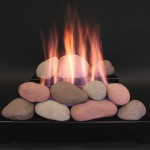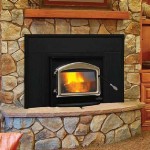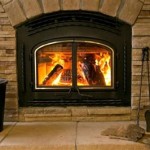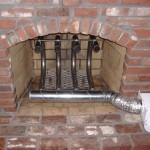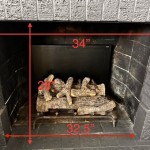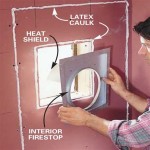Replacing a Prefab Fireplace With a Fireplace Insert: A Comprehensive Guide
Prefabricated fireplaces, also known as factory-built fireplaces, are commonly found in modern homes due to their ease of installation and relatively lower cost compared to traditional masonry fireplaces. However, their efficiency in heating a space is often limited, and homeowners may seek to upgrade their existing prefab fireplace with a fireplace insert. This article provides a detailed overview of the process, considerations, and benefits associated with replacing a prefab fireplace with an insert.
A fireplace insert is a self-contained heating appliance designed to fit inside an existing fireplace opening. Inserts are typically made of cast iron or steel and are significantly more efficient than open-hearth fireplaces, converting a higher percentage of fuel into usable heat. Replacing a prefab fireplace with an insert can substantially improve the heating efficiency of a home, reduce energy costs, and enhance the aesthetic appeal of the fireplace.
Understanding Prefab Fireplaces and Their Limitations
Prefab fireplaces are manufactured in a factory and assembled on-site. They consist of a firebox, a chimney system, and decorative components. These fireplaces are typically designed for aesthetic purposes rather than efficient heating. Their open design allows a significant amount of heat to escape up the chimney, resulting in a net heat loss for the home. Furthermore, prefab fireplaces often have a shorter lifespan compared to masonry fireplaces, and their components may require replacement after several years of use. The fireboxes are also generally smaller, limiting the size and duration of fires.
One major limitation of prefab fireplaces is their compatibility with different types of fuel. Many prefab fireplaces are designed for burning only wood, while others may be approved for burning specific types of manufactured logs. Attempting to burn fuels that are not approved for the fireplace can be dangerous and may void the warranty. This limitation can be a significant drawback for homeowners who prefer to burn alternative fuels such as pellets or gas.
Key Considerations Before Replacing a Prefab Fireplace With an Insert
Before embarking on the project of replacing a prefab fireplace with an insert, several crucial factors must be carefully considered. These factors include compatibility, sizing, installation requirements, and safety standards.
Compatibility: Determining whether the existing prefab fireplace is compatible with a fireplace insert is paramount. Not all prefab fireplaces are designed to accommodate inserts. Some models may lack the structural integrity to support the weight of an insert, while others may have chimney systems that are incompatible with the venting requirements of the insert. Consulting with a qualified professional is essential to determine compatibility. This typically involves inspecting the fireplace and chimney system to ensure they meet the manufacturer's specifications for insert installation.
Sizing: Selecting the correct size of the fireplace insert is crucial for optimal performance and safety. The size of the insert should be appropriate for the firebox opening and the area that needs to be heated. An undersized insert may not provide sufficient heat, while an oversized insert can overheat the space and potentially damage the fireplace. Calculating the square footage of the room or area to be heated, as well as considering factors such as insulation and ceiling height, will aid in determining the appropriate BTU (British Thermal Unit) output of the insert. Manufacturer specifications and guidance from a qualified installer are invaluable resources for proper sizing.
Installation Requirements: Replacing a prefab fireplace with an insert involves specific installation requirements that must be strictly adhered to. These requirements typically include the installation of a stainless-steel chimney liner that extends from the insert to the top of the chimney. The chimney liner is essential for safely venting combustion gases and preventing creosote buildup. Additionally, proper clearances to combustible materials must be maintained to prevent fire hazards. The installation process often involves modifying the fireplace opening to accommodate the insert, ensuring a secure and airtight seal. A professional installer will have the necessary expertise and equipment to complete the installation safely and efficiently.
Safety Standards: Fireplace inserts must meet stringent safety standards to ensure safe operation and prevent fire hazards. Look for inserts that are certified by recognized testing laboratories such as Underwriters Laboratories (UL) or Warnock Hersey (WH). Certification ensures that the insert has been tested and meets established safety requirements. Additionally, it is essential to obtain the necessary permits and inspections from local building authorities to ensure compliance with building codes and regulations. Regular maintenance, including chimney cleaning and inspection, is crucial for maintaining the safety and efficiency of the fireplace insert.
The Installation Process: A Step-by-Step Guide
The installation process of replacing a prefab fireplace with an insert typically involves several steps, including preparing the fireplace opening, installing the chimney liner, positioning the insert, and connecting the vent system. While it is highly recommended to hire a professional installer, understanding the process can help homeowners make informed decisions.
Preparation: The first step involves preparing the fireplace opening by removing any existing components, such as the firebox surround or decorative panels. The firebox should be thoroughly cleaned to remove any debris or creosote buildup. Any necessary modifications to the fireplace opening, such as widening or reinforcing the structure, should be completed at this stage.
Chimney Liner Installation: Installing a stainless-steel chimney liner is a critical step in the installation process. The liner is typically inserted from the top of the chimney and carefully lowered into the existing chimney flue. The liner should be properly sized to match the vent outlet of the insert and should be securely connected to the insert using appropriate connectors and sealants. The chimney liner provides a dedicated vent path for the combustion gases, preventing them from leaking into the house and reducing the risk of chimney fires.
Insert Placement: Once the chimney liner is in place, the fireplace insert can be carefully positioned inside the firebox opening. The insert should be centered and leveled to ensure proper operation. Any necessary adjustments to the insert legs or shims should be made to achieve a level surface. The insert should be securely fastened to the fireplace structure using appropriate hardware.
Vent Connection: Connecting the insert to the chimney liner is the final step in the installation process. The vent outlet of the insert should be securely connected to the chimney liner using appropriate connectors and sealants. The connection should be airtight to prevent any leakage of combustion gases. The area around the insert should be sealed to prevent drafts and ensure optimal heating efficiency. Once the installation is complete, the fireplace insert should be thoroughly tested to ensure proper operation and safety.
Types of Fireplace Inserts: Fuel Options and Efficiency
Fireplace inserts are available in various fuel options, each with its own advantages and disadvantages. The most common types of fireplace inserts include wood-burning, gas, and pellet inserts. Each type offers varying levels of efficiency, convenience, and environmental impact.
Wood-Burning Inserts: Wood-burning inserts are the most traditional type of fireplace insert. They offer the classic ambiance of a wood-burning fire and can be a cost-effective heating option if wood is readily available. However, wood-burning inserts require manual loading of wood, regular cleaning of the firebox and chimney, and proper storage of firewood. Modern wood-burning inserts are designed with advanced combustion technology to improve efficiency and reduce emissions. Look for inserts that are certified by the Environmental Protection Agency (EPA) for low emissions.
Gas Inserts: Gas inserts offer a convenient and low-maintenance heating option. They are fueled by natural gas or propane and can be easily controlled with a thermostat or remote control. Gas inserts eliminate the need for manual loading of fuel and require minimal cleaning. They are also generally more efficient than wood-burning inserts, converting a higher percentage of fuel into usable heat. Gas inserts are available in various styles and designs, including realistic-looking log sets and modern linear designs.
Pellet Inserts: Pellet inserts are fueled by compressed wood pellets, which are a renewable and environmentally friendly fuel source. Pellet inserts offer a balance of convenience and efficiency. They require less manual loading than wood-burning inserts and produce less ash. Pellet inserts are typically equipped with automatic feeding systems that regulate the flow of pellets into the firebox, maintaining a consistent heat output. Pellet inserts are a good option for homeowners who want a clean-burning and efficient heating alternative to wood or gas.
Choosing the right type of fireplace insert depends on individual preferences, budget, and heating needs. Factors such as fuel availability, convenience, and environmental impact should be considered when selecting a fireplace insert.
Benefits of Replacing a Prefab Fireplace With an Insert
Replacing a prefab fireplace with an insert offers numerous benefits, including improved heating efficiency, reduced energy costs, enhanced safety, and increased aesthetic appeal. These benefits make it a worthwhile investment for homeowners looking to upgrade their existing fireplace.
Improved Heating Efficiency: Fireplace inserts are significantly more efficient than open-hearth fireplaces, converting a higher percentage of fuel into usable heat. This improved efficiency translates into lower energy costs and a more comfortable living environment. Inserts are designed to radiate heat into the room, rather than allowing it to escape up the chimney.
Reduced Energy Costs: By providing a more efficient heating source, fireplace inserts can help reduce reliance on central heating systems, resulting in lower energy bills. This is particularly beneficial during colder months when heating costs can be substantial. The savings can be further amplified by choosing a fuel source, such as wood or pellets, that is more affordable than natural gas or propane.
Enhanced Safety: Fireplace inserts are designed with safety features that mitigate the risks associated with open-hearth fireplaces. These features include sealed fireboxes, chimney liners that prevent creosote buildup, and safety shut-off mechanisms for gas and pellet inserts. Installing a fireplace insert can significantly reduce the risk of chimney fires and carbon monoxide poisoning.
Increased Aesthetic Appeal: Fireplace inserts are available in a wide range of styles and designs, allowing homeowners to enhance the aesthetic appeal of their fireplace. From traditional cast iron designs to modern linear styles, there is an insert to suit every taste and decor. Replacing a prefab fireplace with an insert can transform the fireplace into a focal point of the room, adding warmth and character to the living space.

Time To Replace Wood Burning Prefab Fireplace Greenville Sc Blue Sky

Is It Time To Replace That Old Prefabricated Fireplace

Zero Clearance Vs Prefabricated Fireplace Full Service Chimney

New Wood Burning Prefab Fireplaces Complete Fireplace Installs
Options For Replacing Prefab Fireplace Hearth Com Forums Home

Take Your Prefab Fireplace From Drab To Fab In A Snap

New Wood Burning Prefab Fireplaces Complete Fireplace Installs

All About Prefabricated Fireplaces Chimney Savers

Pre Fabricated Fireplaces Canadian Home Inspection Services

Replacing Prefab Fireplace Doors Avoid These Problems
Related Posts

